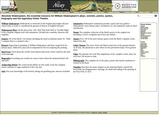
In this video, Amy Walker quickly demonstrates 21 accents from around the globe.
- Subject:
- Arts Education
- Theater
- Material Type:
- Lesson
- Provider:
- Vimeo
- Author:
- Amy Walker
- Date Added:
- 02/26/2019

In this video, Amy Walker quickly demonstrates 21 accents from around the globe.

This blog post by a dialect coach is a list of the six most important things an actor should keep in mind when learning a dialect.

This website is a resource for Shakespeare's plays, sonnets, poems, quotes, biography, and the Globe Theatre.

In this lesson, students will demonstrate basic understand of acting for musicals by selecting lyrics to memorize and dividing it into moments.

Students will demonstrate an understanding of “The Fourth Wall†principles by performing a content-less scene where they will visualize, and/or break, the Fourth Wall.

In this lesson plan, students retell a story using costumes and props to reinforce sequencing.

This lesson plan highlights two approaches to teaching students about bullying through drama. In this lesson, drama serves as a means to highlight and explore bullying issues, giving pupils the opportunity to try out anti-bullying strategies for themselves.

In this lesson plan, students will use pantomime, research skills, and information sharing to perform as someone or something from a country around the world. The teacher "travels" from country to country guessing who/what each student represents. The plan includes a time-travel variation as well.

In this humorous poem, a theatregoer has a bad experience at the theatre due to audience members displaying poor etiquette.

This article explains common audience etiquette that is appropriate for both indoor and outdoor performances.

In this article, the authors Anthony D. Hill, associate professor of drama at The Ohio State University, and Douglas Q. Barnett, director, producer, and founder of Black Arts/West in Seattle, discuss why they created the Historical Dictionary of African American Theater, the first comprehensive compendium of two centuries of blacks on stage.

This series of interactions and assignments covers reading, documentation, writing, evaluations, and performance. It introduces students to Aristotle's Plot Points and helps them find those points in books they are reading. At first this is a small part of a weekly lesson plan, then whole lesson time is devoted to writing, and, finally, students will rehearse and perform their BookTalk.

This article outlines the Do's and Don'ts of Broadway theatre etiquette when attending a live performance.

In this lesson, students will demonstrate their understanding on how costumes and props can affect/form character by drawing a costume design for their scene character and writing a list of props their character might use.

In this activity, students are given an index card. Each student then writes the name of a famous person or character on that card. The cards are shuffled then redistributed amongst the group. The students must become the character on the card they are given and interact with the other characters in a given scenario. While they are interacting in character, each student is also trying to figure out which student was given the character they wrote on the index card.

In this lesson plan, students are led, using narrative pantomime, to act out a story about 3 dimensional space. Following the activity, students discuss their role in this lesson, as well as their community.

This website offers online access to the complete works of William Shakespeare, including comedies, histories, tragedies, and poetry.

In this warmup activity, one student is the conductor, and the other students are the choir. The choir copies the sounds and moves the conductor makes. The conductor can control how loud or quiet the choir is and combine different sounds to create music.

This activity explores a dilemma faced by a character, providing an opportunity to analyze a decisive moment in greater detail.

In this unit, students will engage in an interactive activity that will enhance their understanding of story structure and story elements. Students will work in groups to create semi-impromptu skits. Paper bags containing five unique props are distributed to each group; these props provide the impetus for the development of creative skits. Students then use online tools to outline the story elements in their skits. The lesson also promotes listening skills as students view other groups' performances and determine the conflict and resolution of each.